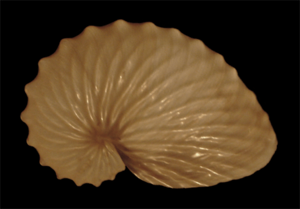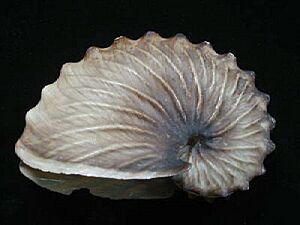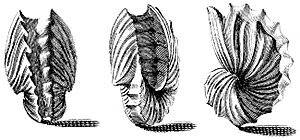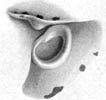Winged argonaut facts for kids
Quick facts for kids Winged argonaut |
|
|---|---|
 |
|
| Eggcase of Argonauta hians | |
| Conservation status | |
| Scientific classification | |
| Genus: |
Argonauta
|
| Species: |
hians
|
| Synonyms | |
|
|
The winged argonaut (Argonauta hians) is a fascinating type of octopus that lives in the open ocean. It's also known as the muddy argonaut or brown paper nautilus. This name comes from the special, thin shell that the female argonaut creates. It looks a bit like a paper shell and is usually grey or brown. In China, people call this animal the "Grey Sea-horse's Nest."
The female argonaut's shell is actually an eggcase. It wraps around her body, similar to how a nautilus lives inside its shell. This eggcase has a wide, almost square shape. It has a few rounded bumps and less than 40 smooth ridges on its sides. These shells are usually about 80 millimeters (about 3 inches) long. Some very large ones can be over 120 millimeters (nearly 5 inches) long! The biggest ever found was 121.5 millimeters.
Contents
About the Winged Argonaut
Where Do Winged Argonauts Live?
Winged argonauts live all over the world in warm, tropical, and subtropical waters. They are found in many different oceans. This species can look quite different depending on where it lives. Scientists have noticed at least two main types, often called the "southern" and "northern" forms.
The "southern" form is common around the Philippines and in the South China Sea. These argonauts are smaller, and their shells rarely grow larger than 80 millimeters. Their shells also don't have the "winged" parts that give the species its name.
The "northern" form lives in places like Taiwan, Hong Kong, and Japan. These argonauts are much bigger, with shells that can reach 120 millimeters. Their shells are darker, stronger, and have the special winged parts. They also look less stretched out and don't have the shiny look of the "southern" form. Scientists are still studying if these two forms are actually different species or just variations of the same one.
What Do They Eat?
Winged argonauts mainly eat other small sea creatures that float in the open ocean. They especially like to eat molluscs. Scientists have found parts of tiny snails called heteropods in the stomachs of A. hians.
Who Eats Winged Argonauts?
Many animals in the ocean prey on winged argonauts. For example, they have been found in the stomachs of a large, fierce fish called the longnose lancetfish (Alepisaurus ferox). This shows they are part of the ocean's food chain.
Reproduction and Life Cycle
Male and female winged argonauts are very different in size. Males are much smaller than females. Males become ready to reproduce when they are about 7 millimeters long. This is likely their full grown size.
Female argonauts start making their special eggcase when they are about 6.5 to 7 millimeters long. They usually begin laying eggs when they are around 14 to 15 millimeters long. By the time females reach 18 to 20 millimeters, they have typically finished laying their eggs. However, the exact size when they lay eggs can vary depending on where they live. Females can grow up to 50 millimeters long, while males usually don't get bigger than 20 millimeters.
Amazing Argonaut Behavior
Clinging to Objects
Winged argonauts are known for clinging to things that float on the sea surface. This can even include other argonauts! Sometimes, you can see long chains of 20 to 30 argonauts of similar size. In these chains, the first female usually holds onto a floating object. The other females then hold onto the shell of the argonaut in front of them. Scientists have even seen strings of six freshly mated female A. hians swimming together.
Riding on Jellyfish
In the open ocean, it's common to see A. hians attached to jellyfish. They have been photographed riding on top of jellyfish like Phyllorhiza punctata in the Philippines. Scientists have known about this behavior for a long time, but they only started to understand why in the 1990s.
Underwater photographer Mark Strickland once saw and photographed a female A. hians clinging to a jellyfish in the Andaman Sea. He noticed the argonaut was using the jellyfish as a way to hide from possible predators, like him! The argonaut would even spin the jellyfish around to keep itself hidden. He also saw the argonaut use the jellyfish as a "hunting platform." It moved its jellyfish host close to a smaller comb jelly, quickly grabbed it with its tentacles, and ate it.
Argonaut Relatives
A. hians seems to be closely related to two other smaller argonaut species. These are A. bottgeri, found in the Indian Ocean, and A. cornuta, which lives in the northeast Pacific Ocean.
The oldest known fossils of A. hians were found in Japan. They date back to a time called the middle Pliocene period. The shape of the A. hians eggcase is also similar to an extinct species called Argonauta sismondai.
Images for kids








